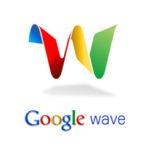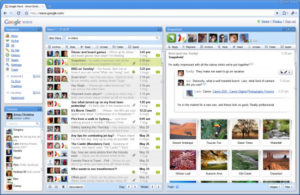
Combining text, audio, and video chat with features like drag-and-drop documents and interactive polls, Google Wave is a free web program that could add unprecedented depth to student interaction, many educators say.
Programmers who designed Google Wave, a tool still in development and only available through limited invites, started with a question: What would eMail look like if it were invented today?
The answer is a format that merges social networking with multimedia in an online meeting space where students and instructors can see each other type in real time, conduct private conversations, and edit documents simultaneously.
Wave also sports a playback option that lets users see the development of an online conversation between students working on a group project. The screen starts out blank and incrementally fills with user activity.
Raymond Schroeder, director of the University of Illinois’s Center for Online Learning, Research, and Service, said an instant replay of students’ waves answers “the age-old question posed to faculty members: How do you know that everyone contributed to the project?”
“With playback, you can view the wave in time-lapse, blip by blip—even those that are deleted. You can see who contributed what at what time to the wave,” said Schroeder, adding that free access to Wave could be a fiscal godsend for IT officials whose budgets have dwindled over the past two years.
“Free is very good,” he said.
Schroeder became one of the country’s first campus IT officials to use Google Wave last month when he connected Illinois’s Internet in American Life course with a class from Ireland’s Institute of Technology at Sligo, participating in a wave that focused on the internet’s role in energy sustainability.
More than a million people have signed up for Google Wave after receiving one of the company’s limited invitations—the same approach the internet giant took during its Gmail rollout.
Google will make Wave widely available after developers rid the program of its rough edges, said Sara Jew-Lim, a Google spokeswoman.
“We are also interested in opening a wider audience for the developers and our partners who have been developing rich integrations, but during this preview, we’ll continue working to improve things like speed, stability, and reliability, in addition to building key features we want in place before making Wave more broadly available,” Jew-Lim said.
The program’s contextual spell check is among the stand-out features that have captured educators’ attention since Wave invites were first dispersed in September.
Wave’s spell checker doesn’t match words against their dictionary spelling, but rather accounts for the word’s context using a complex language model spawned from billions of web pages. Even if a word is spelled correctly, Wave will underline the word in red if it is used incorrectly or out of context.
“It has become so good at spell checking … that we let it automatically correct my errors,” Lars Rasmussen, an Australia-based Google technician and co-founder of Google Wave, said during a Wave presentation last summer.
Google Wave marks the next step in collaboration capabilities that began with eMail and evolved with programs such as Google Docs, which gives users access to the same document so they can edit a project without eMailing it back and forth.
Complaints persist about the lack of Wave invitations and the program’s speed, according to the Google Wave Blog, a company site updated with the latest Wave developments. Users also have complained that Google doesn’t notify them when they receive a request to join a new wave, according to the blog.
“We’re also thinking about how to integrate with existing communication and collaboration tools,” Aaron Cheang, a Google user experience researcher, wrote in a Nov. 27 blog post. “And since we all know that fast is better than slow, a large portion of the team is working to make Google Wave faster.”
Universities to wave good-bye to CMS programs?
Some higher-education technology administrators said Google Wave could replace interactive online classrooms available through expensive proprietary course-management systems such as Blackboard.
The officials—who did not want their names printed because their campuses have long-standing relationships with Blackboard—said Wave could make expensive CMS software obsolete if it’s as good as advertised.
One IT director said her school would “make do with what we have” until Wave is open to everyone.
Tracy Stewart, vice president of information technology at Regent University in Virginia Beach, said sending a document between several students and their professors can leave students confused about which version of the assignment is most up to date.
“You never really know who has the latest version,” said Stewart, who added that Regent’s online courses will use Google Wave when it’s available to the public. “With Wave, you can see the changes everyone is making. … It’s clearly a very powerful tool.”
She added: “We have pent-up demand. When [Google] is ready, we need it.”
Group work via Wave also will be a boon for campus administration, said Menachem Wecker, an editor and writer for George Washington University’s daily web-based newsletter, called George Washington Today.
Articles that require editing and approval from several university staff members, Wecker said, are usually eMailed as Microsoft Word documents. But using Wave, an author can post the text and watch as editors tweak words and punctuation.
“We’ve found that it’s really much faster,” Wecker said. “There’s something very convenient about seeing those changes being made [in real time].”
James Wolf, an assistant professor at Illinois State University’s School of Information Technology, said Wave will one day let his graduate students work on major projects remotely instead of arranging a meeting time and place.
“Finding a time when everyone can meet outside of class can be a real challenge,” Wolf said.
Some in education remain skeptical
Wave’s myriad of enhanced features could prove too advanced for college educators not considered among their school’s most technology savvy, said Nic Nelson, a professor at Hope International University in Fullerton, Calif.
Nelson said Wave is a pliable format for faculty members who can manipulate the program, while for-profit companies such as eCollege give users a design and layout “that’s already been made for you.”
“Google Wave definitely feels, from the get-go, more like a huge lump of modeling clay than a Lego set [that] I can assemble in thirty minutes,” Nelson said. “It demands a significant investment of time, energy, and creativity. Meanwhile, for a fee, [paying for a web meeting space] can give you a basic online classroom with a lot of functionality in 30 minutes.”
Nelson said he would continue using eCollege for his courses but would also dabble in the more malleable Google Wave.
“Google Wave is intriguing, but a far cry from the regular online delivery tools we already use,” he said.
Campus IT officials and computer experts have raised concerns that anyone can add a user to a wave if he or she has the person’s user ID, and people cannot see profile biographies of people on the same wave.
Google’s highest priority should be creating a wave that is less chaotic, some say—an inevitable complaint about an online arena that can let dozens or hundreds of users edit information and type in real time.
“When you have too many people, too many conversations are going on all at once,” said Tom Hausmann, director of IT at Viterbo University in Lacrosse, Wis. “It becomes a bit cluttered when everyone comments on the same thing.”
Dealing with a little online discussion-group clutter might be worth the hassle, Hausmann said, when educators account for the benefits of a free service built with Web 2.0 tools that students use every day on Facebook and other social networking sites.
“Being on a wave by yourself isn’t like surfing, because there’s no value to it,” he said. “It definitely has outstanding potential as a collaboration tool in education.”
Links:
Center for Online Learning, Research, and Service
- Research: Social media has negative impact on academic performance - April 2, 2020
- Number 1: Social media has negative impact on academic performance - December 31, 2014
- 6 reasons campus networks must change - September 30, 2014
